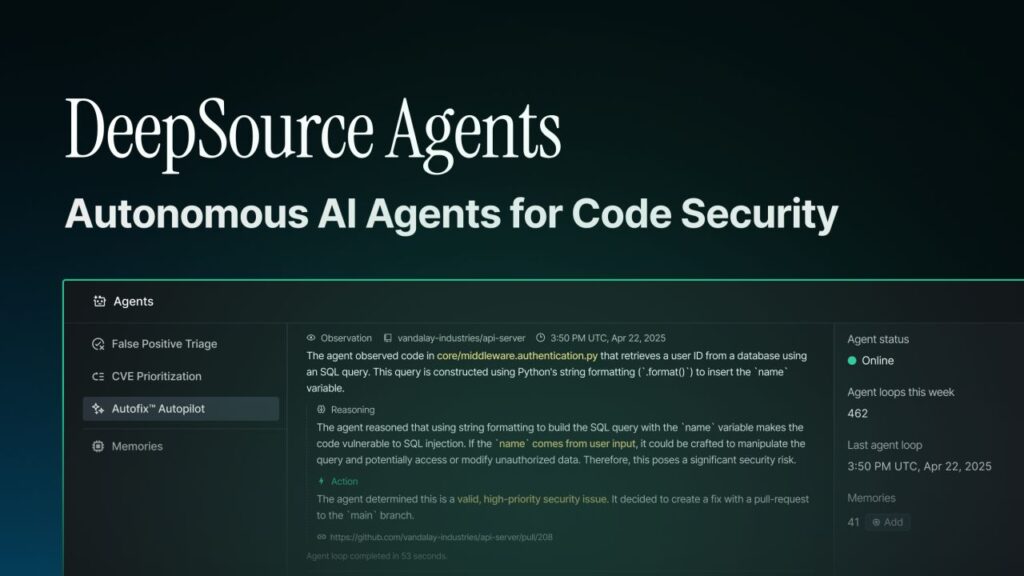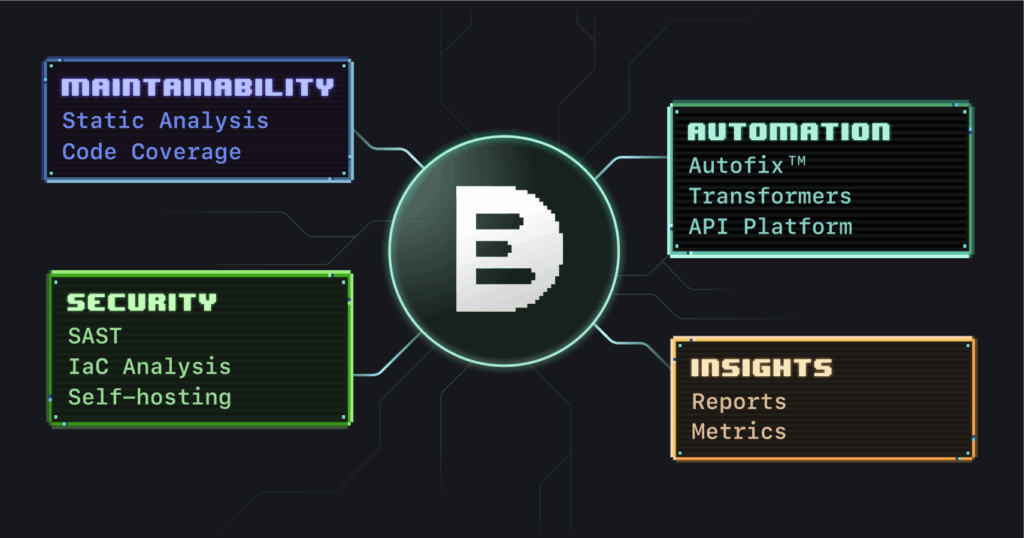We often find coders engrossed in their coding as they aspire to write that pristine piece of code that’ll change the world for the better. A coder with that twinkle in his eye is Sanket Saurav, co-founder of DeepSource, a DevSecOps code health platform that provides organizations with all the tools they need to write maintainable and secure code to improve their software’s stability and increase developer velocity.
StartupBeat spoke to Sanket about the journey of DeepSource, which he started six years ago along with his co-founder Jai Pradeesh.
“I started writing code very early. So, building tools has always been something that I’ve enjoyed. And I’ve been a developer all my life,” he says.
Sanket has been building software products for almost a decade now, starting with small weekend projects from his college dorm room. The self-taught designer, who studied Computer Science and Engineering at NIT Jamshedpur, started his first startup in his second year. He started Design From The Heart, a web-applications design firm, from his college dorm, which specialized in creating web and mobile applications for small businesses in India. He started CampusHash in his pre-final year, which provided paid technical workshops in colleges across the country on technologies like Python, Google App Engine, and Web design with HTML5. In his fourth year, right before graduating, he prototyped his first SaaS product, DoSelect, and moved to Bengaluru with his roommate to work full-time on it.
“This was before DeepSource. When I moved on from that startup and I was looking for new ideas on what to build, this was a natural pull for me, building tools for developers. We had used a lot of other products that helped people write better code, but nothing had ever clicked,” he recalls.
But Sanket felt inspired by that gap in the market.
“I had a lot of ideas on how you could build a 10 x better product, 10 x better product experience for developers for writing better code, and DeepSource was the culmination of those ideas. That’s why we started DeepSource,” he reminisces.
For DeepSource, he participated in Y Combinator, which led to raising multiple rounds of venture funding, onboarding Fortune 500s as customers, and building a team in India and the US. Sanket was also part of the Forbes 30 Under 30 list for Enterprise Technology in North America in 2021.
Building Value
Today, DeepSource customers include startups to Fortune 500s, such as Twilio, Visa, Ancestry, NASA, Sainsbury’s, Intel, Viasat, Aritzia, Moody’s, and more. The startup also just launched a new product for software composition analysis, DeepSource SCA, which helps companies secure their third party dependencies.
“One of my favorite features we’ve shipped in DeepSource SCA is multi-variate Autofix™. When upgrading a package, we show you all possible paths of upgrade with three upgrade risk vectors and an overview of what changed. Saves me a lot of time when fixing patching vulnerabilities,” Sanket said on LinkedIn.
DeepSeek also recently launched Globstar, a new, static analysis toolkit. 100% open source, it helps companies and developers write custom security checkers for their code. For example, a security team identifies a risky pattern and wants to be ready with a code that can secure against that pattern. Using Globstar, the team can codify, systemize, and write a checker for this pattern easily and then implement it in their software development workflow. As their developers write their code, Globstar can run analysis using that checker and make sure that that pattern stays out of the code.
“It’s freely available to everyone, and, it’s super easy to adopt,” he says.
While changing the world is a tall order, Sanket thinks that what they are building is definitely of value because DeepSource has been in the market for quite some time now.
“We have had tens of thousands of developers using the product every day. We have thousands of companies using the product every day. So, I do think it’s very valuable for them. It helps them write better code. It helps them be more productive. It helps them move faster as they build software to further their own business. DeepSource helps them move faster. So, I definitely think that what we’re building is of value,” he says with pride.
Target: Global Audience
As Sanket and Pradeesh started building the product, they wanted to target a global audience, which wasn’t an easy to achieve task.
“Initial challenges were around how do we get the product out to a global audience, to developers who are outside India. Our target market was the Bay Area, because it’s home to a lot of startups who adopt new tools earlier than anyone else in the world,” he recalls.
Both co-founders put immense effort in getting their product to market, launching the product, getting it to the relevant customers and users who were not in their local market.
“Yeah, initially, we did a lot of efforts around that. Before we moved to San Francisco, we used to come here as visitors very often and meet the developer community here, meet startups and showcase our products. That’s how we got over the initial challenges,” he remembers.

New Developer Experiences with AI
With DevSecOps becoming standard in modern software development, AI is elevating it further, scanning code and committing histories to uncover hidden vulnerabilities and anomalous patterns before they become threats. Sanket informs that DeepSource is building an end to end platform for teams, for companies to secure their code. In the near future, more automation is in the wings.
“We are working on AI agents. We are working on Autofix AI, our existing product. The idea is to use AI to elevate productivity for developers and security engineers, and how do we elevate the effectiveness of the tools of our platform so we can help our developers, help our customers ship more secure and cleaner code easily,” he explains.
He thinks the most exciting aspect of AI is that many experiences that were not possible before are now possible.
“As AI becomes mainstream and LLMs become so accessible and also so powerful, a lot of the product experiences that are now possible, were simply not possible three years ago. And that’s the most exciting part. I think, a lot of people have great ideas on how they can build products to make people’s lives better, and a lot of those ideas can now be realized, using AI,” he opines.
He also adds that AI elevates productivity in general across the board.
“It’s not just about developers, but really anyone who’s doing any sort of knowledge work, I think, they are more productive with AI, and this is only going to get better. This is only going to increase the productivity of people. So, you’re able to do more. You’re able to do better things with the help of these tools and do better at your job,” he adds.
However, he points out that AI is just a tool.
“It’s a new kind of tool that helps you do a lot of new things. It helps you be more productive. But in the end, it is just another technology. The idea is to build better products, and that doesn’t change. And even though some things are changing, the core idea for founders who are looking to build new businesses is the same. You need to figure out how to build things that people want, how to build things that actually add value. And, yeah, AI will help you do more things. AI will help you do better things, but the core remains the same,” he says.
“You need to really identify what problems you’re going to solve and how you’re going to solve those and really go after those problems earnestly, using any kind of technology, including AI,” he advises.
The Leader with a Developer’s Heart
Sanket says his experiences as a developer shaped him as a leader today. “Since I’ve always written code, I’ve always been a developer. I think I understand how products are built, and that helps me lead the team in a way that’s more hands on, that’s more grounded in the reality of building products,” he says.
He gets the trope about leaders or CEOs not really having an on-ground experience and managers or leaders setting unrealistic timelines.
“I think that’s something that I have come to understand well, because I’ve always been in the developer’s shoes. So, I understand what it takes to build software and get it out into the hands of customers. With the current team, that’s something that I tend to practice, be very cognizant about the process of building products. But at the same time, making sure that our team, our developers, really understand the impact of what they’re building, that helps me lead them better,” he concludes.

